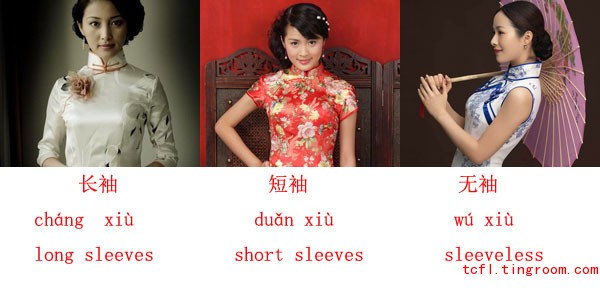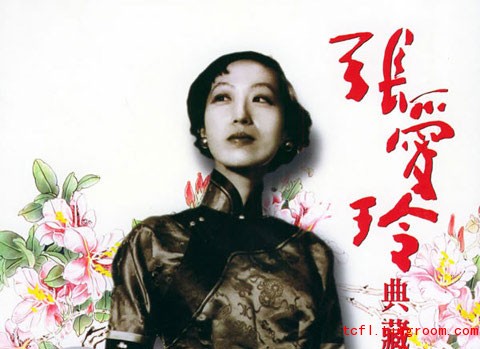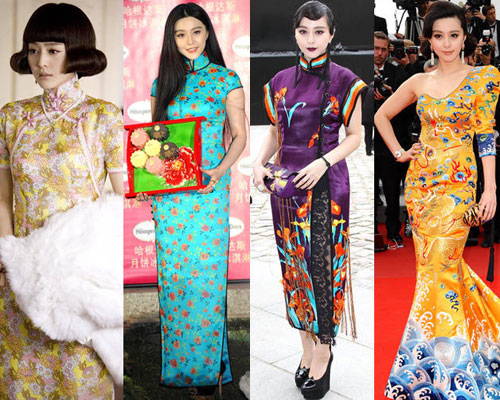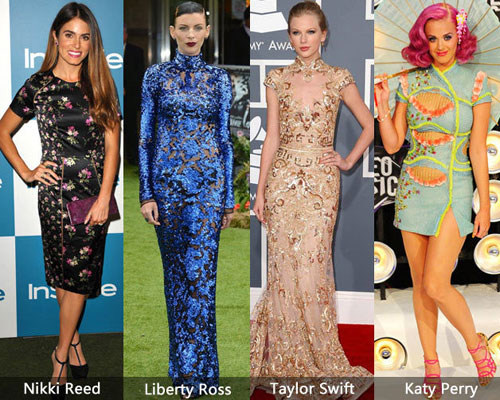Cheongsam, also known as a qipao 旗袍( qí páo ) , is a distinctively traditional Chinese dress originating from the Manchu people of the Qing Dynasty in the early 17th century. It has evolved through the ages and is still used in contemporary Asian female fashion that is created to uniquely emphasize feminine features while preserving its cultural authenticity.
旗袍的传说(chuán shuō) Legend of Qipao
There was a young fisherwoman living near a place called Jingbo Lake. She was not only very beautiful but also clever and skillful. Her only problem: when fishing, she often felt hindered by her long and loose-fitting clothing. Then an idea struck her: why not make a more practical dress to wear when fishing? She then got down to sewing and produced a long, loop- buttoned gown with wonderfully practical slits down the sides of the skirt for tucking in the front part of her dress. Her creation allowed her to fish with greater ease, but she never imagined that it would bring her good fortune as well.
The young emperor who ruled China at the time had a dream one night. In the dream, his dead father told him a lovely fisherwoman wearing a long dress of her own creation, who lived by Jingbo Lake, would become his queen. After awakening from this vivid dream, the emperor sent his men to look for the mysterious woman. And sure enough, they found her just wher his father said? So she joined the emperor as his queen, bringing her lovely Cheongsam with her. Manchu women all followed suit and soon Qipao became all the rage throughout China.
旗袍的历史(lì shǐ ) History of Qipao
The Qipao we see today has been modernized over the years.
In the early years of the Qing Dynasty (1644-1911), long gowns were collarless, narrowly cuffed in the shape of a horse's hoof, and buttoned down front left. They also had a fitted waist. Wearers usually rolled up their cuffs and only unrolled them when hunting or battling, to protect the back of their hands. In the winter, cuffs of the gowns helped keep their wearers warm. The gown had four slits, one on the left, the right, the front and the back. Each slit reached the knees. The gown was fitted to the body and rather warm. Fastened with a waistband, the long gown could hold solid food and utensils for hunting.
Another feature of the Manchu cheongsam was that people generally wore it with a waistcoat that was either buttoned down the front, twisted in the front, or shaped like a lute.
When the early Manchu rulers came to China proper, they moved their capital to Beijing and the cheongsam began to spread to the Central Plains. The Qing Dynasty unified China and standardized the nationwide costume as well. Although the 1911 Revolution toppled the rule of the Qing (Manchu) Dynasty, the female dress survived the political change and, with improvements, has become the traditional dress for Chinese women.
Until the 1930s, Manchu people, no matter male or female, all wore loose-fitting and straight-bottomed broad-sleeved long gowns with a wide front. The lower hem of women's cheongsam reached the calves with embroidered flower patterns on it.
In the 1930s, influenced by the Western thought of women’s liberation, Chinese women reformed the Qipao. The straight collar was lowered. The sleeves were shortened or even disappeared.
From the 1940s on, the cheongsam almost became a nationwide uniform for women. The cheongsam even became the attire for formal social occasions and diplomatic meetings. Later, the cheongsam even spread to foreign countries and became popular with foreigners.旗袍的样式(yàng shì ) Patterns of Qipao
The traditional one-piece, form-fitting dress is either made of silk, brocade, velvet or fabric and is the obsession of every Chinese woman. As Western fashions changed, the basic cheongsam design changed too. There are some unique style elements of Cheongsam such as the collar, the sleeve, the button design, the length and the slit of the dress. Take the sleeves as an example:

代表人物 (dài biǎo rén wù ) Representive figures
A "qipao" chooses its wearer. only when the body goes well with the clothing will the dress come to life and speak for the person wearing it. Take a look at celebrities dressed in gorgeously vying Cheongsams.

张爱玲
Elieen Chang
Chinese writer

邓丽君
Teresa Teng
Chinese singer

范冰冰
Fan Bingbing
Chinese actress

外国女星
Foreign stars
 English
English Japanese
Japanese Korean
Korean French
French German
German Spanish
Spanish Italian
Italian Arab
Arab Portuguese
Portuguese Vietnamese
Vietnamese Russian
Russian Finnish
Finnish Thai
Thai dk
dk